| Reviews & Columns |
|
Reviews DVD TV on DVD Blu-ray 4K UHD International DVDs In Theaters Reviews by Studio Video Games Features Collector Series DVDs Easter Egg Database Interviews DVD Talk Radio Feature Articles Columns Anime Talk DVD Savant Horror DVDs The M.O.D. Squad Art House HD Talk Silent DVD
|
DVD Talk Forum |
|
|
| Resources |
|
DVD Price Search Customer Service #'s RCE Info Links |
|
Columns
|
|
|
Fantasia / Fantasia 2000: Four-Disc Special Edition
Walt Disney Studios Home Entertainment // PG // November 30, 2010
List Price: $45.99 [Buy now and save at Amazon]
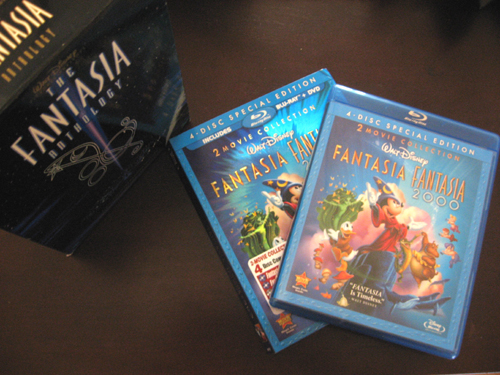
Picture a young, chubby boy adorned with glasses sitting in front of a large TV entertainment center, his fingers grabbing at some fuzzy gray carpet and a pair of antsy feet generating static with their movement. His grandmother, also responsible for teaching him how to shoot pool and putt a golf ball straight, wanted to show him a movie. She had been listening to a lot of Beethoven, Bach, and especially Mozart at the time, something the boy knew, and she made it clear that her enthusiasm for what she'd been listening to was the cause of this impromptu screening. Out came the clamshell case. Now, whether the boy completely processed what he saw in his first tango with Fantasia is suspect, but this is certain: he liked what he saw, and heard. The colors, the characters, and the music entranced his spectacle-laden eyes and welcome eardrums, and, in that moment, the foundation was established for his appreciation for both classical music and visual art. That's the level of impact Fantasia can have on the right, willing child, or even the right, willing adult, an experience that runs the gamut of emotion without the art physically saying a word.
Fantasia:

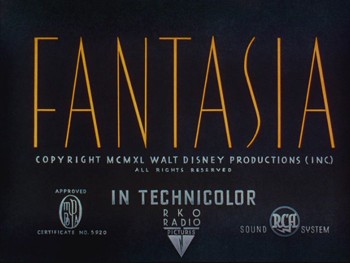 Interestingly, the first Fantasia started out as a way for Walt Disney to resuscitate Mickey, his trademark character, after his popularity had been clouded by spinoff character Donald Duck. He and conductor Leopold Stokowski put their heads together to construct "The Sorcerer's Apprentice", the nine-minute segment that appears in the full Fantasia program, obviously with the same idea in mind as his groundbreaking short Steamboat Willy -- which gave the world something they hadn't seen. After running up a production budget roughly five-times (5x) that of other animated shorts of the time, Disney felt it opportune to create something bigger around his beautiful little idea of marrying classical music and his animation style, if only to try and justify his budgetary hits. In went an idea and a concentration for detail, as well as musings about how to use multi-channel sound in a theater, and out came an audiovisual experience in Fantasia unlike any other.
Interestingly, the first Fantasia started out as a way for Walt Disney to resuscitate Mickey, his trademark character, after his popularity had been clouded by spinoff character Donald Duck. He and conductor Leopold Stokowski put their heads together to construct "The Sorcerer's Apprentice", the nine-minute segment that appears in the full Fantasia program, obviously with the same idea in mind as his groundbreaking short Steamboat Willy -- which gave the world something they hadn't seen. After running up a production budget roughly five-times (5x) that of other animated shorts of the time, Disney felt it opportune to create something bigger around his beautiful little idea of marrying classical music and his animation style, if only to try and justify his budgetary hits. In went an idea and a concentration for detail, as well as musings about how to use multi-channel sound in a theater, and out came an audiovisual experience in Fantasia unlike any other. With Deems Taylor as the narrating guide, Fantasia sweeps through eight animated segments that mix the '40s-era Disney animation style with a forward-thinking eye for the way that its audience perceives cartoons and classical music, along with how the two can intertwine into something poignant -- instead of something that's just frivolous entertainment. Taylor calmly describes each of the pieces before they show on-screen, kind of like the text in a foreign-language opera pamphlet, introducing hints as to whether the piece will be a free-form expression of raw artistry, a direct interpretation of the music, or a reinterpretation that knowingly takes an alternate spin on the music's inherent "story". The material he covers skims the surface of the music's history just enough to be both attention-grabbing and insightful, interconnecting the way that ears pick up on sounds and, in turn, translate to images in the mind. In ways, because of this, Fantasia even tip-toes around explaining how the brain works.
And, wouldn't you know it, the material in the animation -- from the avant-garde expression accompanying "Toccata and Fugue in D Minor" in the opening or the direct Grecian mythology interpretation of the "Pastoral Symphony" -- mirror the musical composition to an arresting and cogent degree. Fantasia represents the core of pure artistry at its most profound, showing how the language of movement, colors, crescendos, and environment overlap into a pure imaginative experience, and how the same piece of art can be seen in very different lights through two different pairs of eyes. This might sound like a stretch, but Fantasia really does encourage its viewers to have confidence in interpreting artwork the way they deem fit, the very bedrock of creative discussion for centuries. It just manifests in a subtle and defined way, streaming within the way the film guides an audience through its array of dazzling experiences.
That awe-inspired sensation, experienced when someone comprehends the art-music marriage in Fantasia, sticks long after they've seen it the first time. It's made it nearly impossible for me to see any ballet version of "The Nutcracker" without envisioning Chinese-inspired toadstools and flamboyant Cossack-dressed thistle flowers, or to hear the peaceful melody of "Ave Maria" around the holidays without the image of glowing candles weaving through a cathedral-inspired forest. And the aggressive brood bubbling in "Night on Bald Mountain" can't be heard without conjuring the image of a ferocious, dream-haunting demon named Chernabog sweeping over a quaint European town, leading into an onslaught of ghosts and devilish denizens that's arguably the most frightening piece of animation ever created --- perhaps second only to the donkey transformation sequence in Pinocchio's Pleasure Island. Every segment of Fantasia carries an impact that'll linger into other experiences one will have with the classical music selections, reminding them of the changing seasons in "The Nutcracker Suite" to a daunting representation of the primordial genesis of life within "The Rite of Spring".
There aren't too many other ways to say it: Fantasia really shines as a beacon of artistic brilliance for its entire two-hour span, and it's truly saddening that it wasn't embraced upon the time of its release. Walt Disney had a daring concept in mind when he cooked up his idea for the animated roadshow; as time progressed, he'd continuously incorporate new animated pieces into his production, rendering a continuously-evolving experience that'd regularly offer something new to returning audiences. But Fantasia was neither a critical nor box-office success, instead dwindling Walt Disney Productions into a financial pinch because of its incurred budget. If only we could go back in time and reassure Disney and his team that they were creating something that'd be celebrated as a true benchmark of art, where their innovation and insight into the connection between expressive mediums would be celebrated as a trued-and-true classic. Then again, most great pieces of art are misunderstood upon their conception anyway.
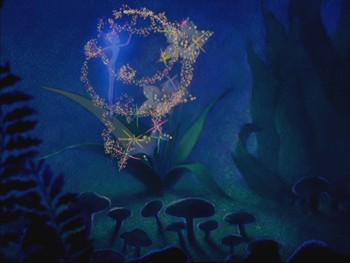 2000 --- ● --- 2010 | 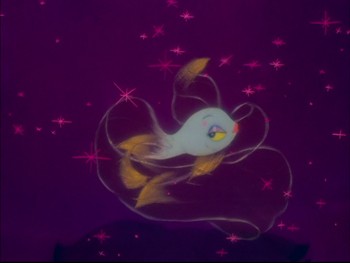 2000 --- ● --- 2010 |
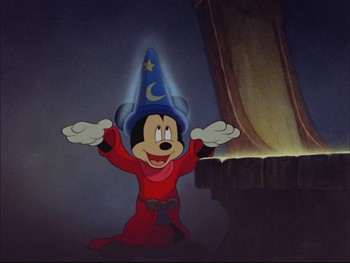 2000 --- ● --- 2010 | 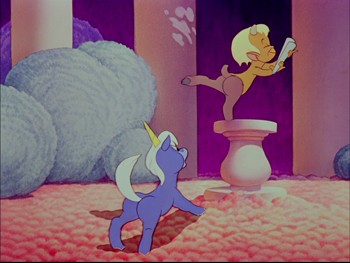 2000 --- ● --- 2010 |
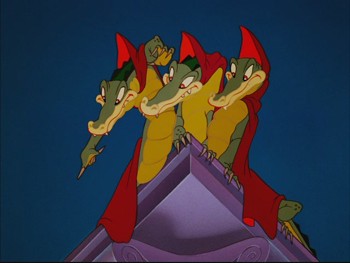 2000 --- ● --- 2010 | 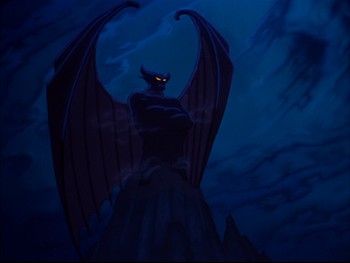 2000 --- ● --- 2010 |
Fantasia 2000:

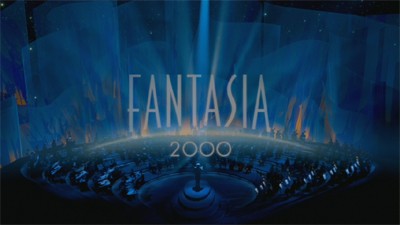 Several years later, that same boy at the beginning of this review -- not so much a boy anymore -- returned to that very same spot on the gray carpet with a clamshell copy of Fantasia 2000 in his hands, ready for a newly-invigorated version of the experience he'd held to such high esteem. Instead of eye-opening, this latest Walt Disney-dedicated production illustrates the shift in the Disney tone over the course of sixty years, skewing more towards straightforward, easier-to-chew artistry and a more ostensibly vibrant keel. It's an ode to the original, a love letter that handles itself similarly, but it wouldn't come close to holding the same impact without its precursor's existence. Nevertheless, the connection between visual and musical art combines again in stunning fashion for its much-brisker 70-minute dash, cobbling together a more youth-friendly enthusiasm that's less engaging for its older audience -- but not all that less-engaging.
Several years later, that same boy at the beginning of this review -- not so much a boy anymore -- returned to that very same spot on the gray carpet with a clamshell copy of Fantasia 2000 in his hands, ready for a newly-invigorated version of the experience he'd held to such high esteem. Instead of eye-opening, this latest Walt Disney-dedicated production illustrates the shift in the Disney tone over the course of sixty years, skewing more towards straightforward, easier-to-chew artistry and a more ostensibly vibrant keel. It's an ode to the original, a love letter that handles itself similarly, but it wouldn't come close to holding the same impact without its precursor's existence. Nevertheless, the connection between visual and musical art combines again in stunning fashion for its much-brisker 70-minute dash, cobbling together a more youth-friendly enthusiasm that's less engaging for its older audience -- but not all that less-engaging. Deems Taylor has been replaced by a cluster of celebrities to talk about each installment, which is disappointing since the sole narrator works much better as a constant guide than the cherry-picked stars trying to force chuckles and cheeky appeal. When Steve Martin gets in front of the orchestra and calls the bow a "stick-thingy" while asking for the camera's attention, when James Earl Jones freaks out about flamingos and yo-yos, or when Bette Midler describes what pieces weren't included in this new Fantasia (which includes Destino), it feels more like head-patting than an involving dialogue. Excluding the coherent discussion from Itzhak Perlman about the "Pines of Rome" and Quincy Jones eloquently describing the phenomenal Jazz-inspired "Rhapsody in Blue", the introductions mostly steer away from elucidation into the musical pieces and more into somewhat releavant surface-level charm. Still charming, of course, but they're not as engaging.
Those same statement about appeal and engagement can be made about the entirety of Fantasia 2000, a compelling work of symphonic pleasure that's more artistically transparent and rudimentary than its inspiration. It still mixes abstract interpretations with the literal and semi-literal, ranging from a mosaic-driven flight of butterflies and bats paired with Beethoven's "Symphony No. 5" to the beat-for-beat projection of Hans Christian Anderson's Tin Soldier story set against "Piano Concerto No. 2, Allegro, Opus 102". But though charming amid flying whales and a flamingo obsessed with a yo-yo, the interpretation of movement within the animation doesn't achieve the same potent emotional connection as its predecessor. And, quite frankly, the maudlin Donald Duck-starring, Lion King-inspired take on Noah's Ark, mixed with "Pomp and Circumstance", pushes so hard on that charm button that it masks the effectiveness of the actual animal progression.
Two pieces really work, though, taking Fantasia 2000 to stunning heights during those bursts. First is "Rhapsody in Blue", an in-progress piece squeaked into the production at the last minute. It takes Gershwin's brassy Jazz essence and pairs it with the artistic flare of Aladdin artist Eric Goldberg, depicting the rhythmic emotional ebb-and-flow in New York City. Clean, streamline angles and minimal taupe-centered coloring brilliantly etch out the baggage that several characters lug around while working at a construction site, paying a gold-digger's bills, trying to find creative expression as a young girl, and being unemployed. The other comes in a classic but visually modern take on Igor Stravinsky's "Firebird Suite", which depicts a vegetation-spreading "Spring Sprite" and her curiosity with her fiery phoenix-like counterpart, a figure more bent on destruction than the creation of life. This scene never fails to remind me of Hayao Miyazaki's Princess Mononoke in its depiction of a nature goddess.
As previously mentioned, Walt Disney intended for the Fantasia experience to gradually incorporate new animation pieces as time rolled on, and I strongly believe he would've been proud to wedge both the "Rhapsody in Blue" and "Firebird Suite" segments square in the middle of it. Perhaps the biggest mistake that Fantasia 2000 makes, though, is mentioning segments that didn't make it through the construction process. When the film mentions a spin on "Ride of the Valkyries" done with gorgeous concept sketches from a Danish artist, a bumble bee ballet, and the name Salvidor Dali, it instantly triggers the imagination into thinking what could've been -- and whether the audience would've rather seen those, instead of one or two of the pieces contained within. What's there still sates a hungry creative mind, but it's not without a twang of disappointment in its brevity and lack of involvement with a willing audience. It will, however, make someone want to break out the original Fantasia, and any reason to do that's alright in this book.
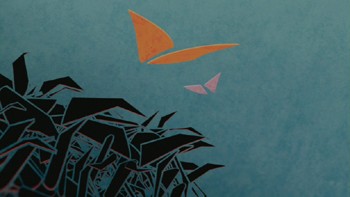 2000 --- ● --- 2010 | 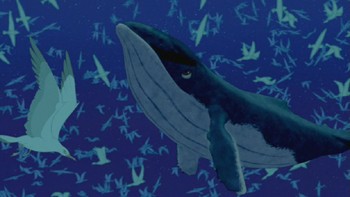 2000 --- ● --- 2010 |
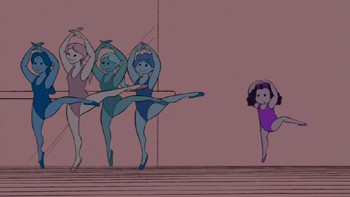 2000 --- ● --- 2010 | 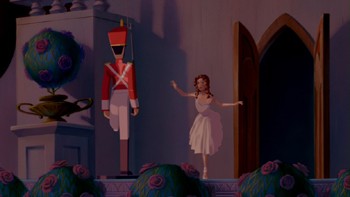 2000 --- ● --- 2010 |
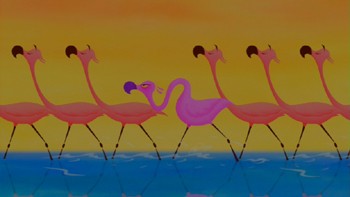 2000 --- ● --- 2010 | 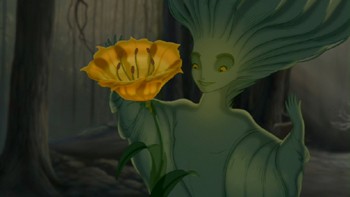 2000 --- ● --- 2010 |
The Blu-ray / DVD:
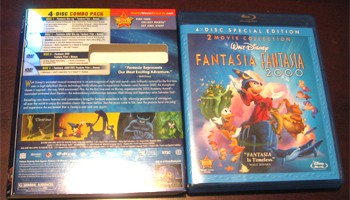 | 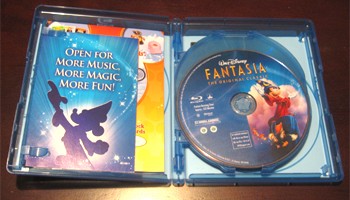 |
Walt Disney Home Entertainment have busted Fantasia and Fantasia 2000 out of the vault for a new high-definition release, gathering them together into a four-disc presentation that includes two Blu-rays and two DVDs. Note that the screen captures in this review are from the new DVDs in this set, and are obviously not the same discs as the 2000 release of the Fantasia Anthology. A dedicated "Blu-ray Guide" or Chaper Listing hasn't been included with this release, with the inserts/leaflets being nothing other than advertisements and some Disney Movie Rewards. Note that the original Fantasia is available to screen in Disney View, with graphical bars on each side of the 1.33:1 image that "fill up" the gaps on widescreen televisions.
-----
A Note About Sunflower:
For most involved in the film community, it's fairly well-known that the "Pastoral Symphony" has been altered from the way it originally showed during the initial roadshow, in that some racially off-putting content has been edited out. That's where Sunflower comes in, a black centaur (actually part human, part donkey) caricature with dialed-up stereotypes that serves the other centaurs by acting out remedial duties. She hasn't appeared in versions of Fantasia since 1969, now only visible by doing a bit of searching on the Internet for clips and stills. This 2010 Blu-ray/DVD presentation of the film doesn't reintroduce her into the film, still seamlessly cropping or scanning away from the character (she'd be in the lower-left corner, underneath the centaurette's hoof). Though the arguments against film censorship and preservation are extremely valid, and it would've been easy to reincorporate the unaltered scene as an option via seamless branching (something Disney really should've done), denying oneself the opportunity to see Fantasia in this fashion would be highly unfortunate for the mere seconds of material that's missing.
Video and Audio:
Disney's excellent track record with their recent high-definition releases continues, with Fantasia and Fantasia 2000 both looking absolutely, jaw-dropping brilliant in their 1080p AVC encodes -- as do the paired standard-definition transfers derived from the same print. Fantasia arrives in its original aspect ratio at 1.33:1, while the matte has been opened for Fantasia 2000 to 1.78:1, revealing more art on the top and bottom. The vividness of the colors will astound in both, allowing it to be pretty safe to say that every single shade of the color spectrum can be found in the expanses of both films. Brushstrokes along edges and in minute details leap out from the artwork much more than in the old Anthology discs, dusting the compression- and grain-heavy visualizations from before. The fins in the delightful fish from the "Nutcracker Suite" show such a delicate gradation in color, the sharpness of contours when the crocodiles dance in the "Dance of the Hours" is staggering, and the overall contrast balance in both pieces -- within hand-drawn and computer-generated work -- leans towards a much more composed disposition. And, aside from the compression/pixelation improvement and the aspect ratio, the only real difference between the Fantasia 2000 prints lies in some evening-out of contrast, which appears pumped up on a few instances in the 2000 DVD. In short, Fantasia and Fantasia 2000 both look astounding, in either the standard-definition or high-definition formats. Period.
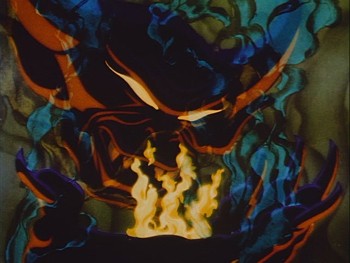 | 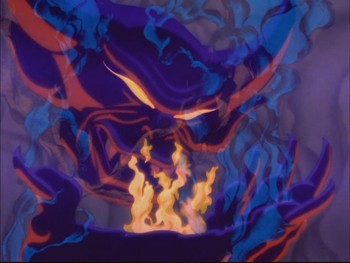 |
| 2000 Fantasia Anthology Click Here for Larger Image | 2010 Special Edition Click Here for Larger Image |
There are some drastic color changes in the classic Fantasia that might come as a shock, and it'd be hard to definitively prove their accuracy -- but I'd be willing to believe that they are. Firstly, the dustiness of the film has been pleasantly lifted from every scene, an extremely welcome sprucing to the original film elements. Now, I'm not anywhere close to a colorist expert and can't even approach claiming how the film initially looked, having only the storyboards, the Fantasia Anthology, and memories of my dusty VHS tape to go by, so the observations from hereon out are simply based on experience. Some scenes greatly benefit from the shifts in color, such as the ostrich performance in the "Dance of the Hours" that harnesses a better intuition of shadows and the aforementioned fish sequence that reveals intended speckles and colors previously unseen. Other decisions alter the ambiance heavily. Fairies in the "Nutcracker Suite" radiate with a more intense glow, while the backdrop shifts from grayish, metallic blues and greens to intense upticks of the same color -- and the sparkles are punchier, pouring clear pinks and yellows through instead of more tempered, inconspicuous shades. Moreover, the color changes in "Night on Bald Mountain" (pictured above) are very intriguing, skewing away from the harsh, ominous blasts of color into a more streamlined and balance palette. Everything hits knockout levels of stunning when in motion, just different from the status quo upon some still shot inspection.
Note that the screenshots included here represent the 2010 DVD quality, while the Blu-ray exhibits a more dynamic gradient within the same color palette.
The audio treatments for Fantasia and Fantasia 2000 are darn near impeccable within a pair of 7-channel DTS HD Master Audio presentations, while the standard-definition Dolby Digital tracks jog right along with them with tremendous clarity. The Fantasound stereophonic design concocted specifically for Fantasia's roadshow, an idea cooked up by Walt Disney's dissatisfaction with current recording methods and Stokowski's experiments in dimensional aural design, fills the sound space with crisp and well-balanced instrumental fluidity, expertly handled by Disney's team. Very little age can be heard in the strings, woodwinds, and brass, while Deems Taylor's voice can be heard clear as day -- though that wasn't really an issue even stretching back to the DTS track from the Anthology set, which did have its share of problems with harshness and mild distortion. Fantasia 2000 sounds equally robust to its classic counterpart in an apples to oranges sort of way, though that's expected given its young age. Both are stunning representations of the material, wrapping up the listener in an engulfing, well-balanced and almost painfully beautiful high-definition audio delivery. 5.1 DEHT tracks are available in French and Spanish languages, along with English SDH, French, and Spanish subtitles.
Special Features:
 It's only once the discussion reaches the supplemental features for Fantasia and Fantasia 2000 that it hits a speedbump. The Anthology set comes with commentaries and featurettes on each of the discs in the Anthology, as well as an entire DVD chock full of supplements -- also know as the Fantasia Legacy -- for all the segments spread across the two films. At a glance, it seems as if this new four-disc edition hasn't carried over a huge chunk of those. However, the key item to keep an eye on once under the hood of the Fantasia 2000 disc is the "Virtual Vault" (BD-Live), which allows access to a wide number of the introductions, production pieces, deleted animations, making-of features and other assorted elements. And it works, with relatively quick load times, but with one caveat: the videos can't be viewed full-screen, only in somewhat small windows on the Virtual Vault interface. Though it's nice to have access to these supplements over the web, it's unfortunate that they didn't simply repurpose the Fantasia Legacy disc for this release. But if someone's online capable, the Virtual Vault will offers hours of substantive extra material.
It's only once the discussion reaches the supplemental features for Fantasia and Fantasia 2000 that it hits a speedbump. The Anthology set comes with commentaries and featurettes on each of the discs in the Anthology, as well as an entire DVD chock full of supplements -- also know as the Fantasia Legacy -- for all the segments spread across the two films. At a glance, it seems as if this new four-disc edition hasn't carried over a huge chunk of those. However, the key item to keep an eye on once under the hood of the Fantasia 2000 disc is the "Virtual Vault" (BD-Live), which allows access to a wide number of the introductions, production pieces, deleted animations, making-of features and other assorted elements. And it works, with relatively quick load times, but with one caveat: the videos can't be viewed full-screen, only in somewhat small windows on the Virtual Vault interface. Though it's nice to have access to these supplements over the web, it's unfortunate that they didn't simply repurpose the Fantasia Legacy disc for this release. But if someone's online capable, the Virtual Vault will offers hours of substantive extra material. Fantasia:
Three Audio Commentaries can be played with the film, one that's brand new with Brian Diblet and two others taken from the Anthology DVD -- the Canemaker track, and the Roy Disney track. Both the original commentaries are very good, sharing insight on Disney's creative process (and some actual archive recordings of Walt), but this new Sibley track is astonishingly comprehensive. His enthusiasm shows with each passing second of the track, revealing symbolism, artistic choices, and ways that Fantasia has inspired other films -- such as Ray Harryhausen's Clash of the Titans work, and the Chernabog's stature on "giant" films -- with its design. He never shies away from discussing how the artwork was achieved, getting technical yet accessible with the techniques used (charcoals), while also revealing the depth of the mythology behind each of the visual renderings. And yeah, he even discusses the censorship during the Pastoral Symphony, both of Sunflower and of the nude centaurettes. A must-listen commentary, if there ever was one.
Along with the commentaries, Fantasia arrives with a Disney Family Museum (4:05, HD AVC) "advertisement" and an extensively insightful, relatively lengthy piece on a particular artifact in the museum entitled The Schultheis Notebook: A Disney Treasure (13:51, HD AVC), which reveals a lot of the pages from the piece -- mathematical calibrations, charts, storyboards, all basically kind of like looking under the hood of Fantasia and marveling at its gears -- and discusses the information via assorted interviews. Rounding out the on-disc supplements is a "static" image viewing feature, the Interactive Art Gallery, which takes many of the sketches and storyboards from the Anthology's Legacy disc and plops them in an easy-to-navigate and streamlined interface.
Fantasia 2000:
Two Audio Commentaries make their way over to Fantasia 2000, though they're the same tracks available on the original Anthology DVDs -- one with Roy Disney, James Levine, and Don Ernst, and another with the directors and art directors for each segment. Also on the disc, a piece entitled Musicana (9:30, HD AVC) reveal an earlier version of the "revamped Fantasia" that came close to manifesting in the late-'70s. It reveals the creative process Mel Shaw and Woolie Reitherman
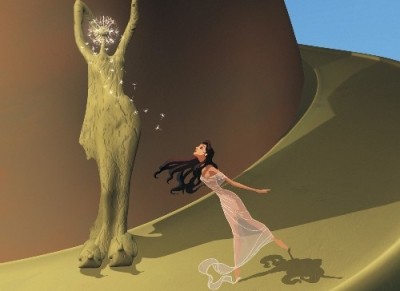 had churned out, showing how many of the "modernized" segments might play out in a new version of Disney's original ideas. Some of the storyboards and chalk drawings make an appearance in the piece.
had churned out, showing how many of the "modernized" segments might play out in a new version of Disney's original ideas. Some of the storyboards and chalk drawings make an appearance in the piece. Then, there's Destino (6:31, HD AVC). Bette Midler's dialogue alludes to several ideas that were created for Fantasia 2000 that didn't manifest, one of which is described as "an idea that featured baseball as a metaphor for life" from "Salvador Dali ... you know, the limp-watches guy". What she's actually referring to is a collaboration project between Salvador Dali and Walt Disney, two starkly-different artists, that sparked in the '40s and got shelved during World War II. Dali and Disney scripted and storyboarded this piece -- specifically with House of Mouse artist John Hench -- where a woman witnesses (and undergoes) surrealist transformations in a desert locale, one very familiar to Dali's aesthetic. But that's not even close to the only elements of Dali's aesthetic present in Destino; ants crawling, contorted faces moving, a dancer's body molding into the surroundings, and other hallucinatory images in the vein of the artist are littered throughout, but not in a hokey faux-Dali sort of way.
Destino lives and breathes with Dali's construction as a backbone, and it reflects as such. The flow of the woman's movement gave me chills on numerous occasions, while the obscurity of the Dali-driven visual contortions are just about as challenging as some of his more complex paintings. The short, along with an extensive documentary on the piece entitled Dali and Disney: A Date with Destino (1:22:18, SD MPEG-2), make a case for spending the price tag slapped on the Fantasia Blu-ray just for these "extra features" -- and for six minutes of footage. For the record, Destino shows a good deal of grain and some speckles here and there, while the standard-definition musical recording of Armando Dominguez's Mexican-infused song hisses and pops with age. It still, however, looks exceptional, and it's a joy to have it widely available.
Final Thoughts:
Fantasia sparked artistic interest in me at a young age, and still perseveres as the foundation for my perception of animation, classical music, and interpretation of art as a whole. So yes, this review is a tad biased. Will one have the same experiences with it? Who knows, but I certainly hope so. Even if it doesn't rustle up a newly-invigorated appreciation for the arts, the experience in watching a cohesive melange of celebrated classical pieces and "golden age" Disney animation will still ensnare someone within a spellbinding experience. Oh, and Fantasia 2000 ain't too shabby either; it's not even close to the same caliber as its inspiration, but still a unique audiovisual experience that feeds off the same vein.
Arriving at the decision to give this Fantasia / Fantasia 2000 Blu-ray DVDTalk's Collector Series stamp of approval wasn't an easy one to reach. Fans of the film(s) will want/need to purchase the set for the drastically-enhanced improvements in both visual and aural aptitude, which Disney seems to improve upon with every release they crank out, along with the spectacular new commentary from Brian Sibley attached to Fantasia and the Shultheis Notebook feature. But this Virtual Vault ordeal -- and the nagging need to hold onto the Fantasia Anthology set for the Legacy disc -- makes it a bit difficult to belt out an unswerving call for a purchase. Sure, the option's there to watch the material on the Vintage Vault, and it works, but the requirement for Internet access makes it frustrating. Ultimately, what nudged the recommendation was the Dali-Disney collaboration Destino, which, as far as can be told at this point, will only be available on the Fantasia 2000 Blu-ray disc and not a standalone release of the original Fantasia. That combination of attributes makes it essential to drop the price on this bushel of beauty. DVDTalk's Collector Series.
|
| Popular Reviews |
| Sponsored Links |
|
|
| Sponsored Links |
|
|
| Release List | Reviews | Shop | Newsletter | Forum | DVD Giveaways | Blu-Ray | Advertise |
|
Copyright 2024 DVDTalk.com All Rights Reserved. Legal Info, Privacy Policy, Terms of Use,
Manage Preferences,
Your Privacy Choices | |||||||











